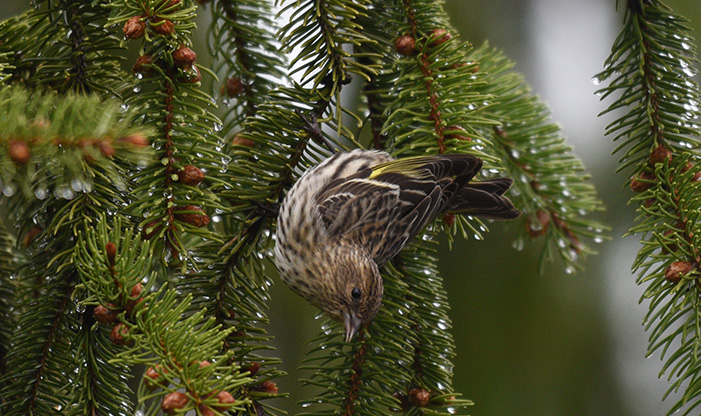When we think of migrating birds, we may imagine birds flying south to tropical climates. However, some birds, such as the finches from the frigid climate of northern Wisconsin and Canada, venture to our part of the state during the winter. The search for food prompts several winter finch species to travel near and far, sometimes in large flocks. These finches eat mostly seeds, buds, berries, and insects when available. Some finch species are common at the Center year-round, while others visit only during winters when food becomes scarce in the northern boreal forest.
Finches range in length from 3-10 inches, and are part of the family Fringillidae, possessing compact bodies, conical bills, and notched tails. Their heavy bills are perfect for cracking the seeds of grasses and weeds, which helps them live in the colder northern climates. The 17 North American species include siskins, grosbeaks, crossbills, redpolls, and the colorfully plumed goldfinches.
Finches Seen in Wisconsin
American Goldfinches (Spinus tristis) are considered short distance migrants, but in Wisconsin, we are fortunate to see them all year long. During spring and summer months, male goldfinches dazzle us (and their mates) with bright yellow plumage highlighted by black and white. In winter, the males take on more camouflaged hues of browns with some black, similar to the females. They frequently visit thistle feeders and can also be found foraging in mixed species flocks.
The House Finch (Haemorhous mexicanus) is a familiar feeder bird. It is not native to Wisconsin but rather a species introduced from the western United States and Mexico. Their fondness for living and nesting near human homes has allowed them to increase their range across the eastern half of the country. Like the American Goldfinch, House Finches are year-round residents in Southeastern Wisconsin.
Purple Finches (Haemorhous purpureus) have a similar appearance to House Finches, making them difficult to distinguish. The males of both species have red-colored plumage on their heads, but Purple Finches display a deeper raspberry hue that stretches all the way down their backs. The Purple Finch’s winter range extends across the eastern United States. These finches prefer conifer and mixed forest habitats and will migrate sporadically to follow abundant cone crops. Their populations are in decline due in part to increasing competition from House Finches.
Irruptive Finch Species
Natural cycles and conditions in the northern boreal forest can lead to widespread seed crop failures during some years. Finches rely on the availability of tree seeds like birch, alder, spruce and even some berries to survive the harsh winters. When there are not enough seeds in certain areas, birds become nomadic, wandering to lower latitudes in search of alternative food sources. The phenomenon of birds moving in large numbers outside of their range is called irruptive migration. These migrations often follow patterns based on years when certain tree species produce less seeds. During years of scarcity, large flocks of northern finches can be observed south of their normal range, including at bird feeders. Every fall the Finch Resource Network posts predictions of finch movements in their Winter Finch Forecast based on their observations of northern seed crops.
Pine Siskins were once considered sporadic winter visitors, but sightings are becoming more consistent every year at the Center. Slightly smaller than their close relative the American Goldfinch, the Pine Siskin (Spinus pinus) has streaky brown plumage lined by yellow on the wings and tail and a sharply pointed bill. They forage on a variety of seeds, flitting high up in the canopy all the way down to the ground to look for fallen seeds. These slender, acrobatic finches are known for hanging upside down on the tips of branches and even on backyard thistle feeders.
Common Redpolls (Acanthis flammea) find their way to southern Wisconsin during years when birch seeds are scarce. These irruptions tend to follow a two-year cycle, with birds remaining farther north in years of abundant seed crops. These tiny, streaked finches sport a small red patch on their crown. They are active foragers who will visit bird feeders, sometimes in large flocks.
A truly irruptive species, White-winged Crossbills (Loxia leucoptera) migrate south to our area only when seeds from spruce and tamarack cones are scarce. These hefty finches are a captivating sight with bright red males showing contrasting black and white wings. However, their most unique feature is their crisscrossed bill which is used to pry open cones and extract the seeds.
When you visit the Center this winter, be on the lookout for winter finches in the conifers and at the feeders. You may be greeted by these delightful little seed eaters!


